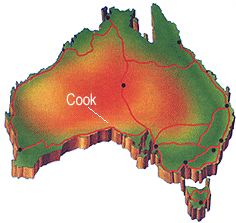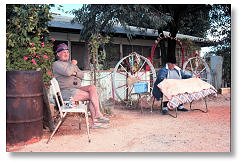|
=
If the term "middle of nowhere" ever meant anything, it must certainly apply to the remote railway town of Cook, SA. One hundred kilometres north of the Great Australian Bight, Cook is smack in the middle of the featureless Nullarbor Plain. Home to a Bush Church Aid hospital, a store, a school, a dozen (or so) persistent families, a railway workshop and a diesel store, we came along this contrived little hamlet in our 4WD en route to Kingoonya. I say 'contrived', because the town was built in 1917 to serve the Transcontinental Railway and houses only railway workers, a nurse and a teacher.
Our bold, high-tech Ford Explorer with wide chunky tyres, looked like something out of NASA amid the chaos and mayhem of railway tools, diesel pipes, heavy machinery and corrugated iron sheds. Sensing our disappointment, foreman Grant Schubert, took us on a guided tour of the town (in his well-worked HiLux), introducing us to some of the few remaining residents, and letting us climb the diesel tanks for a bird's eye view.
As we chatted in the shade of a fragrant pepper tree, the familiar blast of a diesel locomotive could be heard in the distance. The Nullarbor Plain is billiard-table flat, and on the far-western horizon a long, unwriggling caterpillar slowly edged closer to town. It was 3PS6, as we found out, a 1200 metre, 2700 tonne general goods train on its way east.
Our forward journey shattered by the loss of our only spare tyre, we had to backtrack to Ceduna (with fingers crossed), leaving behind the dusty outpost of Cook and its hardy little community. I still marvel at the resilience of these tough desert folk and will always remember with great fondness our accidental encounter with them. The sad postscript to this story is that Cook is no more. Australian National Railways was sold in late 1997 and the new owners split up the organisation. Declaring the settlement of Cook redundant, they emptied the town of its people and buildings and, I fear, of its history.
See also: Across the Nullarbor for a detailed account of the entire crossing. Story and Photographs by Roderick Eime All content, unless noted otherwise, is copyright to the author and may not be reproduced or mirrored without prior express consent in writing. The author is duty-bound to prosecute unauthorised use of material from this site and will do so without hesitation. Prior permission is not required to link or reference material from this site, although the author appreciates notification. |
 Postcard From Cook
Postcard From Cook  As we'd shredded a tyre on the rocky road up from the Eyre Highway, we went looking for some help. We chatted with the blokes in the workshop who gave us the bad news: "Unless ya got a Toyota HiLux, mate, we got nothin' ".
As we'd shredded a tyre on the rocky road up from the Eyre Highway, we went looking for some help. We chatted with the blokes in the workshop who gave us the bad news: "Unless ya got a Toyota HiLux, mate, we got nothin' ".

 The Bishop Kirkby Memorial Hospital next door doubles as a community centre where locals are treated for anything ranging from sunstroke to snakebite. There, Bush Nurse Anneliese Cusack counsels and cures the dozen or so locals, and near-locals, in the spotless weatherboard cottage.
The Bishop Kirkby Memorial Hospital next door doubles as a community centre where locals are treated for anything ranging from sunstroke to snakebite. There, Bush Nurse Anneliese Cusack counsels and cures the dozen or so locals, and near-locals, in the spotless weatherboard cottage.